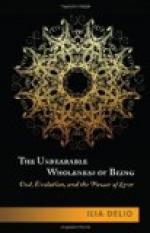“The love that moves the sun in heaven!”
(d) Michelangelo.
In Michelangelo we meet the spirit of Plato and the plastic genius of Greece raised to a higher plane and lit by the peculiar glory of Christianity—the conception of the soul as an absolute value. Michelangelo was thrilled by a passionate love of beauty; beauty absolute, eternal and immutable. He felt profoundly the need of salvation, and he possessed an unprecedented power of spiritual vision. In the end, added to all these things, came consuming love for a woman, love raised to the pitch of self-destruction, an adoration which entitles us to regard him, next to Dante, as the greatest metaphysical lover of all times.
At the court of the Medici at Florence, Ficinio had founded a Platonic Academy, where Plato’s works and the writings of Plotinus—his greatest pupil—were after two thousand years translated and elucidated. Many read and a few understood, but only in Michelangelo did the spirit of Platonic Hellenism revive and become productive; the Platonic ideal of a purely masculine culture, aesthetically and spiritually perfect, illumined his soul; once again the unconditional cult of beauty and the love of the perfect male form, which speaks to us from the Dialogues, quickened an imagination, and boyhood and youth were portrayed in a manner which has never since been equalled.
Nearly all Michelangelo’s youthful male figures—with the exception, perhaps, of the gigantic David—deviate from the decidedly masculine and approach the mean, the human in the abstract; thus they seem to us imbued with a quality of femininity; they even exhibit decidedly female characteristics. I have in mind first and foremost the youths depicted on the ceiling of the Sistine Chapel (the most soulful adolescent figures in the world), but also Bacchus, St. John, Adonis and the figures in the background of the Holy Family at Florence. Cupid and David Apollo (in the Bargello) are almost hermaphroditic, and even the Adam, and the unfinished Slaves in the Bobili Gardens exhibit female characteristics. Without going further into detail I would draw attention to the breasts and thighs, which positively raise a doubt on the question of sex. (I am referring to the two youths above the Erythrean Sybil.) Seen from a distance they create the impression of female figures, while the youth above Jeremiah is a perfect Hellenic ephebos. On the other hand—with the exception of two of his early Madonnas and, perhaps, Eve—he has not given us one glorified female figure; all his women are characterised by something careworn and unlovely; some of his old women—most strikingly the Cumaic Sybil—are depicted with absolutely masculine features, masculine figures and gigantic musculature. His ideal was the Hellenic ideal, was a human form neither man nor woman; all extremes, but also all peculiarities and everything personal, were, if not completely suppressed, at any rate pushed




